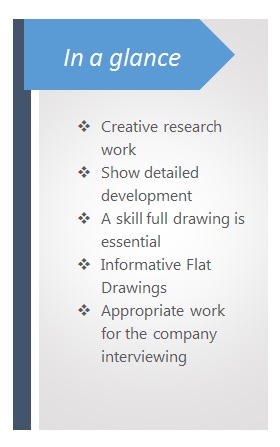A fashion portfolio represents your inner designer and your talent. Whether you are applying for a fashion design school or a young talent trying to make his/her debut, a portfolio would be the representative. So, it is essential to create your fashion portfolio the way it highlights your skills as well as represents the real designer in you. Let’s have a look to the things that can turn a simple fashion portfolio into a great fashion portfolio.

1. Proper research
Your portfolio should be focused on the purpose it is being prepared for. Whether it is the school or the firm you are going to contact with, make sure you understand the portfolio requirements accordingly. There would always be some particular requirement for a particular school, for example, design projects, a sketchbook, or a toile etc. so if you are approaching with an amusing work of art in your portfolio yet no sign of the sketchbook or design project, there is a fat chance you could lose the opportunity.
Note: you can always ask for a permission to show your outstanding projects that do not include in the requirements.
2. Make your portfolio flexible
The portfolio should be flexible as you can take out or add in the projects. It is not necessary to have an expensive bulky or glamorous, however, it is important that the presentation should be attractive and smart.
Note: always keep a digital version of your portfolio.
3. Development
A lot of people look forward to find out about the development of the project and see the process in which the person has gone through to get to his/her final product, as that is the core responsibility of any role in most fashion jobs. So, do not forget to show the research, development, experimentation and all other related stuff. It justifies your concept when you are able to explain your coherent design work.
Note: do not include any kind of unprofessional photos in your portfolio.
4. Drawings
Your portfolio must contain sketches or drawings of your projects. Sketching is one of the essential skills of a fashion designer and it should be always highlighted in your resume.
Note: Do not forget about the presentation, whether in terms of your sketches or the projects. Don’t forget Fashion is all about the PRESENTATION.
When you are done with assembling of the essential and required things to include in your portfolio, make sure they all follow a right order. And, that would be starting with the project presenting your strongest skills and ending with the second best project so that your work would be memorable.
Conclusion
Your fashion design portfolio serves as your designer identity, crucial for school applications or industry entries. Tailor it meticulously to meet specific requirements, emphasizing standout projects with permission, and maintain both physical and digital versions for flexibility. Showcase your design journey, from research to final product, and highlight your sketching skills professionally. Explore some of our student’s portfolios to gain inspiration and elevate your own.
To truly master the basics of fashion design, joining an offline course is the optimal choice. With hands-on projects, guidance from industrial experts, portfolio assistance, and placement preparations, you’ll gain invaluable practical experience and insight into the fashion industry. Explore how to make a fashion design portfolio and elevate your skills at Dreamzone.
FAQs
What is the purpose of a fashion portfolio?
A fashion portfolio showcases your skills, creativity, and talent as a designer. It’s essential for applying to fashion schools or pursuing job opportunities in the fashion industry. A well-prepared portfolio demonstrates your design process and final products, reflecting your personal style and expertise.
How can I organize my fashion portfolio effectively?
Organize your portfolio by starting with your strongest work and ending with your secondary projects. Group similar types of work together and use clear sections for different categories, such as sketches, completed projects, and technical drawings.
What common mistakes should I avoid when creating a fashion portfolio?
Common mistakes include including too many projects, having a disorganized layout, using low-quality images, and neglecting to show the design process. Ensure that your portfolio is concise, well-organized, and showcases both finished designs and the development process.
How can Dreamzone’s fashion design programs help improve my portfolio?
Dreamzone’s programs include practical projects, industry insights, and portfolio development workshops. These elements help you enhance your portfolio by adding high-quality projects, refining your design skills, and presenting your work professionally.
How important is it to have both a physical and digital portfolio?
Having both a physical and digital portfolio is important as it provides flexibility and convenience. A digital portfolio allows you to share your work easily online, while a physical portfolio can be beneficial for in-person interviews and presentations.
How often should I update my fashion portfolio?
Update your fashion portfolio regularly to include new projects, skills, and experiences. Aim to refresh it with recent work at least every 6 to 12 months to keep it current and relevant.

